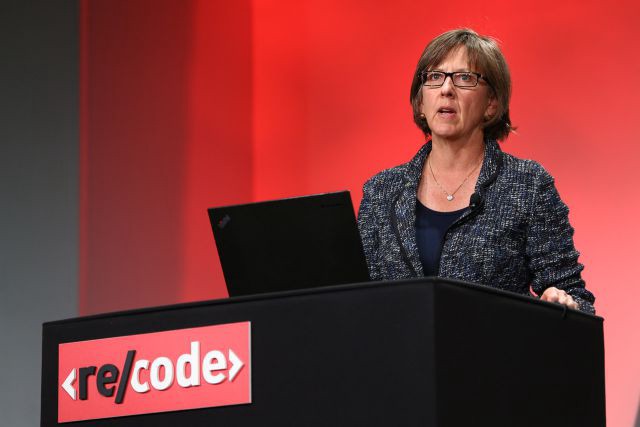Code Conference kicked off this week, which means it’s that time of year for KPCB partner Mary Meeker’s annual Internet Trends presentation. KPCB released Meeker’s full trends deck, which is worth a read for a more comprehensive analysis of the demographic, economic, and digital trends impacting the world today.
Here are five trends that stand out:
1) Digital experiences are becoming increasingly mobile in nature
It’s no secret that we live in a multi-platform world. People are constantly immersed in digital experiences — whether these are articles, videos, or social streams — no matter where they are in their day.
The big shift here is in the time spent among each of these channels. Whereas time spent on computers is relatively static, people are finding more time for digital in their day by using mobile devices. Before, that spare time wouldn’t have been utilized digitally — unless you tend to pull out your laptop as you walk to lunch or commute to work.
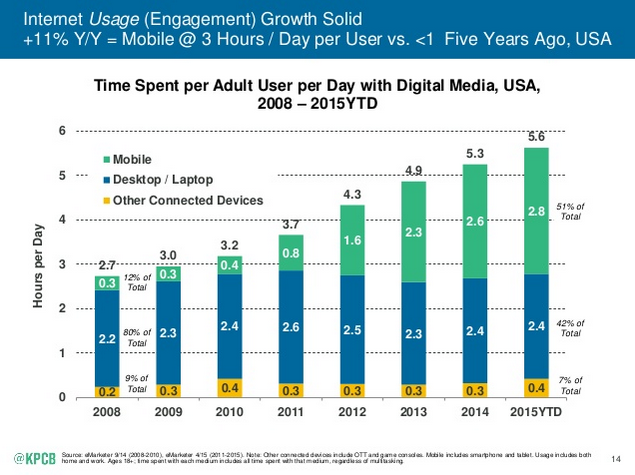
How does this impact brands? When nearly half of Fortune 500 companies are not presenting mobile-friendly content to their audiences, there is still an opportunity for brands and publishers to be ahead of the curve and design their content and experience around all of the devices that people use in their daily routines, not just the old office desktop computer. You cannot assume that users’ habits on mobile and desktop are the same.
Eighty-seven percent of Millennials say their smartphone never leaves their side, day or night, Meeker notes. How could any brand ignore that kind of personal habit?
2) Devices and communications channels need to weave seamlessly into a person’s day
As people become more engaged online, they want experiences that fit into their daily media habits. Website traffic from so-called side-doors has increased steadily — people are significantly less likely to come to a site directly anymore. They will find content on social networks and through messaging and email with friends and family, not their bookmarks tab.
People need to find ways to streamline their digital interactions. This means responding to notifications without having to exit their current app, getting notifications without having to take their phone out of their pocket, and a whole host of new interactivity.
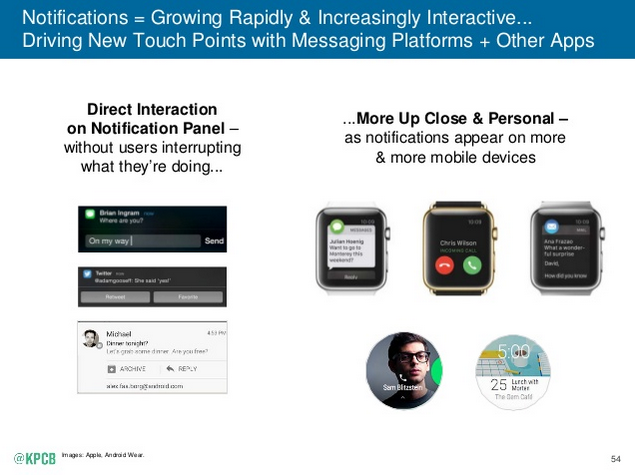
How does this impact brands? Brands need to find ways to integrate themselves into this world seamlessly, not disruptively. Before creating an app, think about whether people are likely to leave their normal media stream to go to that app. Is content integrated into the most used social platforms?
3) Messaging apps are playing a more important role in global communications and content sharing
Messaging apps are starting to expand into more comprehensive communications platforms. Bringing it back to Meeker’s presentation last year, the leading messaging apps have the potential to drive content, community, and commerce for their users.
Publishers especially need to be aware of how messaging app habits are evolving in order to capture attention on mobile. Not only are these platforms among the largest in terms of dark social sharing, but they also are hubs for experimentation, including weekly newsletters, election updates, and native content (following in Facebook’s footsteps).
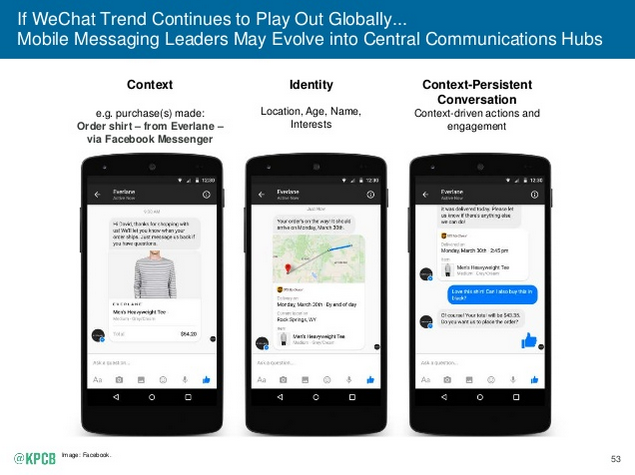
How does this impact brands? Messaging apps have the potential to be the primary hubs for meaningful conversations in the next five to ten years. Meeker cites Tencent WeChat in China, which hosted 41 percent of the 200MM views of “Under the Dome,” a long-form investigation of smog in China, beating out news websites, apps, and Weibo. If this is where the conversation is going to be, brands and publishers need to be there too.
4) User generated content is becoming more prevalent
It has become easier than ever for people to contribute directly to the media conversation, no matter where they are. As Meeker points out “user control” has accelerated over the past fifteen years — from yesterday’s VCR to today’s Chromecast.
Content isn’t coming from just the newsdesk anymore, it’s coming from the people who are already part of the news. Platforms such as Dataminr and Banjo are making it easier than ever for brands to find the conversation and identify the news as it’s happening, in real time.
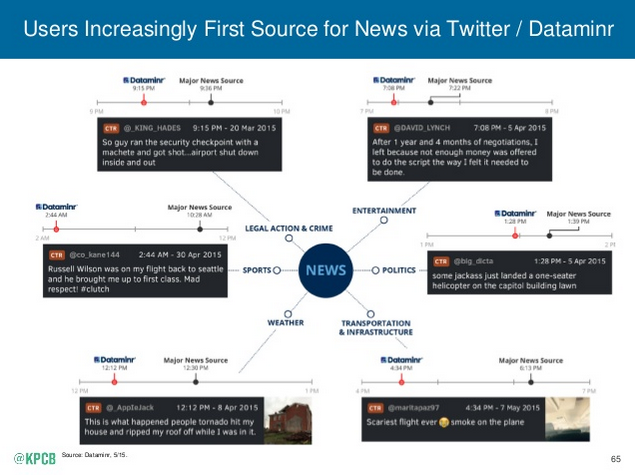
How does this impact your brand? As you’re looking to find ways to connect with your audiences, remember that it’s a two-way street. Don’t just look for avenues to push content out — instead look for ways to incorporate content that is already out there. Your audiences will appreciate being a direct part of the conversation. Use platforms to help you figure out where the relevant conversations are, and become a part of them!
5) Core design choices are fueling shifts in user behavior
Would “swiping right” mean anything without Tinder? Likewise, hasn’t Google’s streamlined homepage made an indelible impact on how people view the search engine medium? These design choices are no small part of the shift in media habits over the past decade.
As Meeker points out, sometimes the most impactful design is a result of what is left unstated, such as Instagram’s decision to remove the choice for landscape or vertical photos.

How does this impact brands? Brands or websites are no different at their cores — both need deliberate design choices to make them a permanent part of any digital rotation. Make sure design is aligned with your digital strategy.
